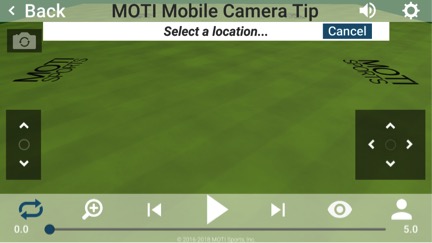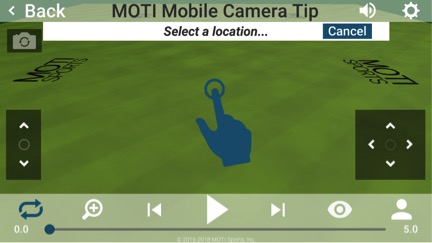Welcome back to the 4-part series on MOTI Mobile Camera Controls for Drills. In this article the Pivot-In-Place and Rotate-Around-Location camera modes will be reviewed and explained. Utilizing these modes, a complete view of the field and play is possible.
To recap, the review of the camera modes is divided into 4 different parts. Topics for the 4 parts are:
- Overview – Part 1 will introduce basic motion options (finger-gestures and on-screen joysticks) and provide a high-level overview of each of the camera modes.
- Pivot-In-Place and Rotate-Around-Location (this article)– Part 2 is a detailed overview of two modes that provide a very flexible overview of the drill. As a note, Pivot-In-Place is the default mode when a drill starts.
- Follow-Player, Follow-Ball, Track-Player and Track-Ball – Part 3 will explore the ‘follow’ and ‘tracking’ options. These modes facilitate focusing on specific player/ball in a complex drill.
- Top-Down Perspective – Part 4 covers a viewing of the field that will be very familiar with players of some of the most popular real-time strategy games.
Review
The first article introduced the mechanisms available to move the camera (section Motion Controls), the way to access the camera modes (section Camera Modes Menu) and a high-level overview of the camera modes (section Camera Modes). The content of these sections will be used as a basis of this article. Read the first article if these concepts are unfamiliar or a refresher is needed.
Camera Modes Menu (shown as activated)
Pivot-In-Place (see below, yellow #1) and Rotate-Around-Location (see below, yellow #2) are highlighted below.

Pivot In Place

This camera mode allows the user to easily look around with finger gestures and move with the joysticks. This is the default mode.
Activating
Activating this mode is accomplished by selecting the Pivot-In-Place icon from the Camera Modes Menu. Once selected, the Pivot-In-Place icon on the menu button will indicate that the mode is active.
This mode is controlled by both finger gestures and the on-screen joysticks.
Finger Gestures
The figure gestures will change the direction that the camera is pointing. Essentially, allowing the user to “look-around”. The finger gestures behavior is defined as follows:
Sliding up/down will change direction that the camera is pointing up/down, respectively.
Sliding right/left will change the direction that the camera is pointing to the right/left, respectively.
On-Screen Joysticks
The elevation and location joysticks will change the location of the camera without changing the direction that the camera is pointing. The joystick behavior is defined as follows:
Elevation Joystick will increase/decrease the elevation of the camera without changing the where the camera is pointing.
Location Joystick will move the camera in the direction of the arrows without changing the where the camera is pointing.

Rotate Around Location
This camera mode allows the user to rotate around a single location on the field. A good way to visualize the behavior of this mode is to imaging tracing a finger over the surface of the upper half of a ball.
Activating
Activating this mode is accomplished by selecting the Rotate-Around-Location icon from the Camera Modes Menu. Once selected, an instruction bar will appear near the top of the screen with a message and a “Cancel” button (see below). Pressing the “Cancel” button will cancel changing the mode of the camera and revert to the previous mode.

Instruction Bar
The instruction bar will show the message “Select a location…”. This is prompting the user to single touch a location on the field (see image below with touch-point) that will be the point-of-rotation. The camera will rotate around the point-of-rotation, continually looking at it.

Once the point-of-rotation has been selected, the Pivot-In-Place icon on the menu button will indicate that the mode is active.
This mode is controlled by both finger gestures and the on-screen joysticks.
Finger Gestures
Using the figure gestures will move the camera as if on the surface of a ball. The distance between the camera and the rotation-point will remain constant. The finger gestures behavior is defined as follows:
Sliding up/down will increase/decrease the elevation, respectively, while keeping a constant distance to, and continually looking at, the rotation-point.
Sliding right/left will change the location of the camera to the right/left, respectively, while keeping a constant distance to, and continually looking at, the rotation-point.
On-Screen Joysticks
Using the joystick will move the camera in different directions in relation to the rotation-point and change the distance to the rotation-point. The joystick behavior is defined as follows:
Elevation Joystick
Pressing the buttons of this joystick will increase/decrease the elevation of the camera while continually looking at the rotation-point.
Location Joystick
Pressing the buttons on this joystick will move the camera in the direction of the arrows while continually looking at the rotation-point.
Summary
In this second article, we have covered the Pivot-InPlace and the Rotate-Around-Location camera modes. With these modes, the user can view the entity of the play from various angles/locations. In subsequent articles, more camera modes will be reviewed in detail.
View Part Three of this article series on App Camera Control here.

I have been working on MOTI Sports software since 2010. I work on enhancements to the 3DST 3D Coaching Play Simulation tool (3D Playbook) and I am the author of the MOTI Soccer App. Prior to joining MOTI, I worked on a variety of animation and visual programming including 3D flight simulator for Hughes Aircraft.

